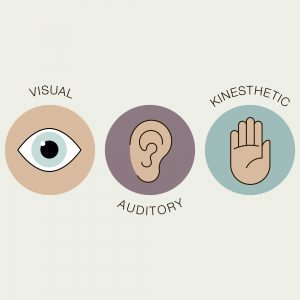
17 Jan What are the Learning Styles that Best Suit your Child?
Over the years, pedagogical learning theories have identified different “intellig
Seven different learning styles
Visual (Spatial): The visual learner learns by seeing. People with strong spatial intelligence are good at geometry, maps, and puzzles. In addition to books, the classic instrument for the visual learner, the Montessori classroom provides colorful materials that are attractive to the visual learner. The map work is a particularly engaging geographic puzzle.
Aural (Auditory-Musical): An auditory learner learns by listening. Having a teacher sit and explain how a material works is vital for an aural learner to understand the concept. One-on-one Montessori lessons allow a teacher to take time and personally talk a child through a lesson until they have mastered it. Books on tapes, reading stories, and listening to music are other ways to engage an aural learner.
Verbal (Linguistic): The verbal learner learns by talking through it. While most classrooms are one-sided, with teachers lecturing and students listening, a Montessori classroom allows the child to engage with the materials and talk with a teacher or other students during the lesson.
Physical (Kinesthetic): The kinesthetic learner learns by doing and touching. Here is where the Montessori classroom shines. All the materials are meant to be touched and manipulated. There are very few paper worksheets–math, for example, is taught with golden beads, and the alphabet is learned via sandpaper letters.
Logical (Mathematical): The logical learner employs deductive reasoning, logic, and cause and effect to understand more abstract ideas. While Montessori materials can explain concepts in the most basic and concrete ways, they can also emphasize more complex concepts: for instance, while the beadwork can be a fun exercise in sorting and grasping (good for fine motor skills), it can also be used to demonstrate concepts of multiplication and division.
Social (Interpersonal) and Solitary (Intrapersonal): Socially or emotionally intelligent people empathize with others. They have high “EQs”. The solitary intelligence understands their own feelings and emotional needs. The Montessori classroom allows children to work in small groups, with partners, or by themselves, giving the child the freedom to be as social or solitary as they need to be on any given day.
Sugar Mill Montessori addresses multiple learning styles
In addition to these, even more learning styles have been added, including naturalist, musical, and existential. Every individual has a mix of all these different intelligences. Whatever your child’s learning strengths are, Sugar Mill Montessori lessons and materials are designed to be flexible. A single material can address multiple learning styles.



Sorry, the comment form is closed at this time.